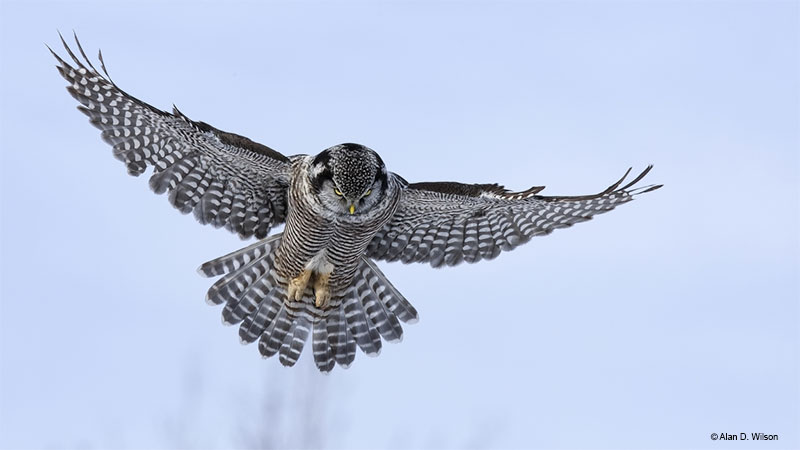The Northern Hawk Owl is a medium-sized owl with a pointed, long tail. It has an oval-shaped body, and it flies on short pointed wings.
Northern Hawk Owls inhabit boreal forests. They got their name from how they behave – they look like an owl but act like a hawk.
These solitary birds stick to the boreal forests, but during the winter months, they’ll move into the northern portions of the United States. Northern Hawk Owls don’t seem to be scared by humans. In the middle of the day, they’ll perch on top of solitary trees, making them easy to spot.
However, they’re harder to locate at night because they roost in tree branches, often tucked between branches or close to the trunk.
On this page
Identification
Northern Hawk Owls have white faces with distinct black borders. Their eyes are yellow, have brown horizontal stripes across their underparts, white spots, and brown above.
These birds are 14.2 to 17.7 inches (36-45 centimeters) long, weigh 8.5 to 16.0 ounces (240 to 454 grams), and have a wingspan of 27.9 inches (71 centimeters). They’re smaller than a Great Horned Owl and larger than a Boreal Owl.
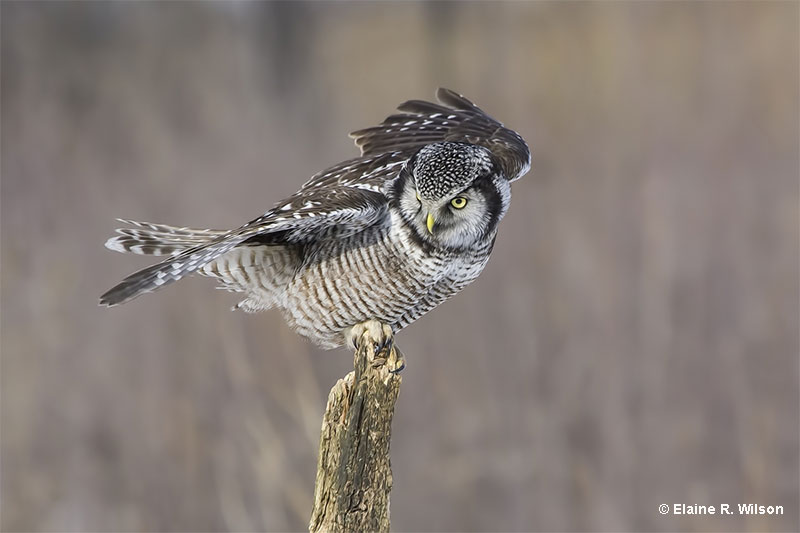
© Elaine R. Wilson
Female Northern Hawk Owls look identical to male Northern Hawk Owls. Juvenile Northern Hawk Owls look very similar to adults. They’re medium-sized and have long tails. They look fluffier and are paler than adults.
Food
The Northern Hawk Owl primarily eats voles, which are small rodents. They’ll also eat small mammals like lemmings, mice, and birds, including ptarmigans, jays, grouse, starlings, and robins. However, sometimes these birds will go after larger prey like Snow-shoe Hares.
Northern Hawk Owls are excellent hunters and have a variety of different hunting techniques.
The first is the “sit and wait” method. This method involves the bird sitting and waiting on an open perch. This gives them a nice view of their surroundings. At this point, all it needs to do is wait for any unsuspecting prey to wander by.
Once it spots something, it swoops down and grabs it with its sharp talons and strong feet. Another method is these birds like to fly close to the ground as it searches for food. Then, if it spots something, it may shortly hover above its prey before dropping down to capture it.
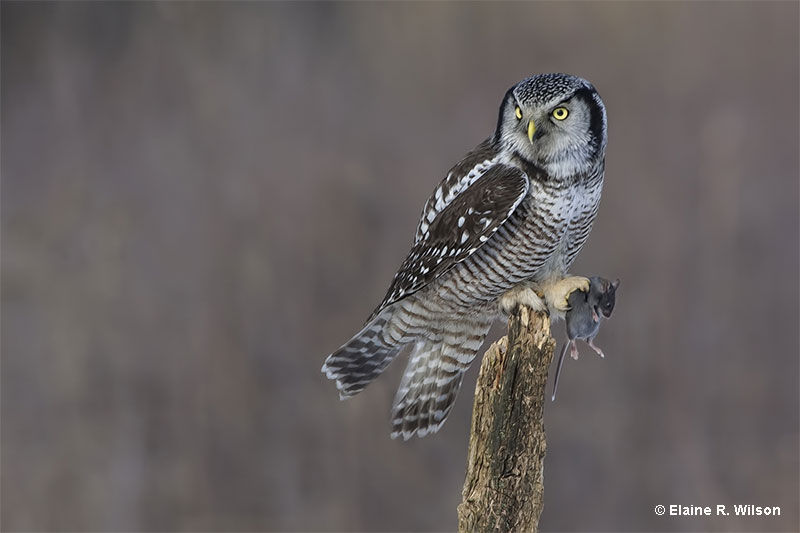
© Elaine R. Wilson
Like most owls, these birds have incredible hearing. Sometimes, it only uses its hearing to find and catch its prey. Some small animals travel underneath the snow to travel back and forth without being seen by predators. This may work well against some predators, but not when it comes to Northern Hawk Owls.
These owls can detect small animals moving beneath the snow just by the sound they make when they move. When ready, these owls will drop feet first into the snow, more often than not hitting their target!
Nesting and Eggs
Both male and female Northern Hawks Owls are the ones to pick a nesting site. Sites tend to be along the forest edge or in open forests with scattered trees. All spots are usually near water.
Northern Hawk Owls nest in cavities in trees that have naturally decayed, were created by woodpeckers, or in broken tree trunks. They do not add any materials to the nesting cavity, but the floor tends to have fur and pellets from prey these parents have brought into the nest.
Occasionally these birds will nest in nest boxes, use old stick nests, or on cliffs.
Northern Hawk Owls generally have one brood during the breeding season. There are 3-13 eggs, that the parents incubate for up to 30 days. After that, the young owls stay in the nest for 20 to 35 days.
Current Situation
Northern Hawk Owls are rare birds. Their preferred habitat, northern boreal forests, are hard to access, making it hard to assess populations. They have an estimated breeding population of 200,000 individuals.
According to the IUCN Red List, Northern Hawk Owls are a species of low concern. Northern Hawk Owl populations fluctuate due to the availability of small mammal prey. Forestry methods that involve clearcutting large swaths of boreal forest most likely lower hunting perches and nesting sites for these birds.
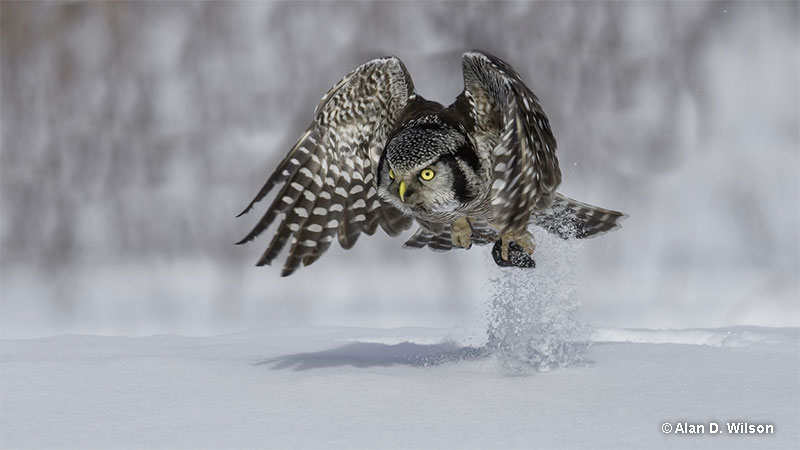
© Alan D. Wilson
The Northern Hawk Owl resides in marshes with a few trees that provide good perches, mixed forests that border open areas, and open coniferous forests.
Boreal forests that have been burned also provide good foraging areas and nesting sites. During years of large populations moving south, they frequent lakeshores, prairies, pastures, and wooded farmlands.
Facts
- The oldest Northern Hawk Owl lived to be at least 5 years and 11 months old. It was found in Canada.
- Northern Hawk Owls have incredible hearing. They’ll dive into the snow to catch small mammals below the surface.
- The Northern Hawk Owl will sometimes wander into areas significantly farther south than their normal range. This usually happens because their prey is scarce.
- The Northern Hawk Owl can find prey with their sight up to 800 meters away.
- Northern Hawk Owls are not really scared of humans. They’re not afraid to attack if something approaches owlets too closely.
Similar Species
The Northern Hawk Owl has features that are similar to other birds. Here are some similar species:
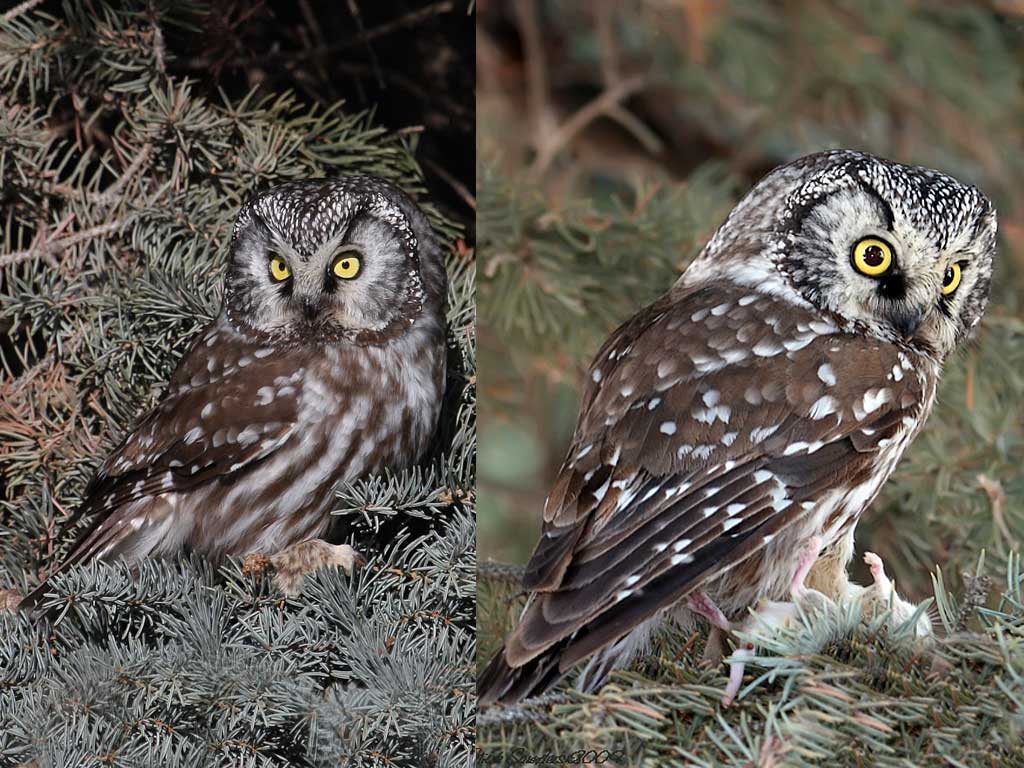
Boreal Owl
Boreal Owl
Northern Hawk Owls are larger and have longer tails than Boreal Owls. Their plumage looks similar, but Northern Hawk Owls have a barred chest and belly.
Another way to identify one or the other is by looking at their faces. Northern Hawk Owls have a hawk-like look, while their head is shaped like an owl. Boreal Owls have a softer look, which gives them a surprised expression.
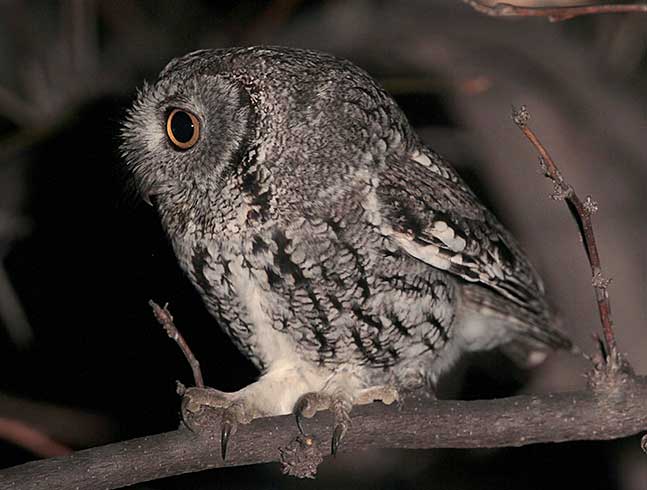
Western Screech-Owl
Western Screech-Owl
Northern Hawk Owls are larger than Western Screech-Owls. Western Screech owls have ear tufts that look similar to the Great Horned Owl‘s, but they are significantly smaller.
Apart from that, Western Screech Owls have a lightly striped belly.
Frequently Asked Questions
Is the Northern Hawk Owl endangered?
No, the Northern Hawk Owl is not endangered. However, it is an uncommon bird. They have an estimated breeding population of 200,000 individuals.
How big is the Northern Hawk Owl?
These birds are 14.2 to 17.7 inches (36-45 centimeters) long, weigh 8.5 to 16.0 ounces (240 to 454 grams), and have a wingspan of 27.9 inches (71 centimeters).
Where do Northern Hawk Owls live?
The Northern Hawk Owl resides in marshes with a few trees that provide good perches, mixed forests that border open areas, and open coniferous forests. Boreal forests that have been burned also provide good foraging areas and nesting sites. During years of large populations moving south, they frequent lakeshores, prairies, pastures, and wooded farmlands.

